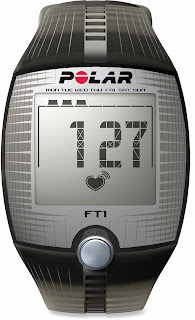Heart rate monitors provide valuable feedback whether we're in our running or climbing phases. Knowing our heart rate makes training time as efficient as possible. Here's how:
There are two basic training modes; aerobic and anaerobic. The former literally means "with air" while the latter is the opposite. Training aerobically means the body's demand for oxygen does not outstrip its ability to supply it. Aerobic training runs are longer and less intense.
Anaerobic training refers to a specific ability to do work in the absence of oxygen, commonly referred to as "oxygen debt." Anaerobic training runs are shorter and far more intense. Interval training on the track and repeats on hills are two examples.
For our high-altitude purposes, we're relying on the running to improve our oxygen-carrying capacity. Running at certain intensities improves the whole system by strengthening the heart muscle and creating a larger network of capillaries probing deeper into muscle tissue. We achieve this goal more efficiently by using the heart rate monitor and capping our maximum heart rate while remaining "in the zone" for longer periods.
Say Hello to Aerobic Max
Depending on our age and physiology, each of us has a maximum aerobic potential. Generally, aerobic max lies around 75-80 percent of our maximum heart rate (you can find your rough maximum heart rate for training by subtracting your age from 220). If you are overweight or sedentary or both, your aerobic max may be lower, at least for now.
A warning before we go further: Consult your physician before embarking on any training regimen. Also, trainees may require less intensive training to work up to their maximum aerobic potential. Being more ambitious than your body's ability to adapt is a well-worn pathway to injury so ease into it.
For most of the population, the heart rate for maximum aerobic potential lies somewhere between 130-160 beats per minute. Use the chart above as a guideline, at least to start. Training near maximum aerobic potential creates the maximum amount of blood volume and pressure, thereby forcing capillaries deeper and deeper into muscles. The more we develop our capillary network, the easier it is to provide working muscles with oxygen and glycogen. Having an underdeveloped circulatory system starves muscles for oxygen and glycogen just as sure as trying to eat by sucking a turkey through a straw.
Running at sustained levels above maximum aerobic potential creates two major problems. First, the heart beats so rapidly, the valves slam shut before the chambers are full so the overall volume and pressure go down. Second, lactic acid forms in the muscles in the absence of adequate oxygen supply. Slowing down allows us so achieve our stated aims; improving cardiovascular efficiency and maximizing training time.
We use the heart rate monitor to ride herd on ourselves. For our purposes, even the simplest monitor will do. I use a Polar FT1 retailing for $59.95. The display shows heart rate while in training mode. I can set maximum and minimum heart rate alarms. Set them at least five beats above your aerobic max, otherwise you'll go crazy with the alarm beeping. Afterwards, I can see my exercise time plus max and average heart rates. That's it. So don't break the bank needlessly.
Also, my heart rate monitor uses a chest strap transmitter. In my opinion, non-chest-strap monitors are a waste of money. Some require stopping for 20 seconds while placing a finger on a pad. Save your money and take your pulse instead. Others don't get the finger but they are still inaccurate. A monitor with a chest strap is plus-or-minus one beat-per-minute accuracy no matter the price or manufacturer. You'll get over the strap in about 30 seconds.
The Moving Threshold
Above 10,000 feet, my "aerobic threshold" drops about ten or 15 beats. That's why I advocate using the monitor while climbing as well. If I exceed my adjusted threshold, I get about 20 minutes before my legs are smoked. No amount of rest stops will revive them for long. Five or ten beats below my aerobic threshold and I can climb until next Tuesday. Having said that, sometimes I induce oxygen debt on purpose during training climbs for short stretches to increase my anaerobic capacity. More on that in the future.
We are all "prisoners" of modern life. We are all busy and oversubscribed. Get the most from your valuable training time. There is no excuse for neglecting your training. Others are counting on you. Give yourself the best possible chance to summit. Start now and adapt. Climb. Run. Monitor. Succeed. Enjoy.
Like Mt Whitney Quest on Facebook



No comments:
Post a Comment
OK guys, let's keep 'er civil and mannerly. This is not a political site so diatribes of that ilk are not welcome and won't be published.